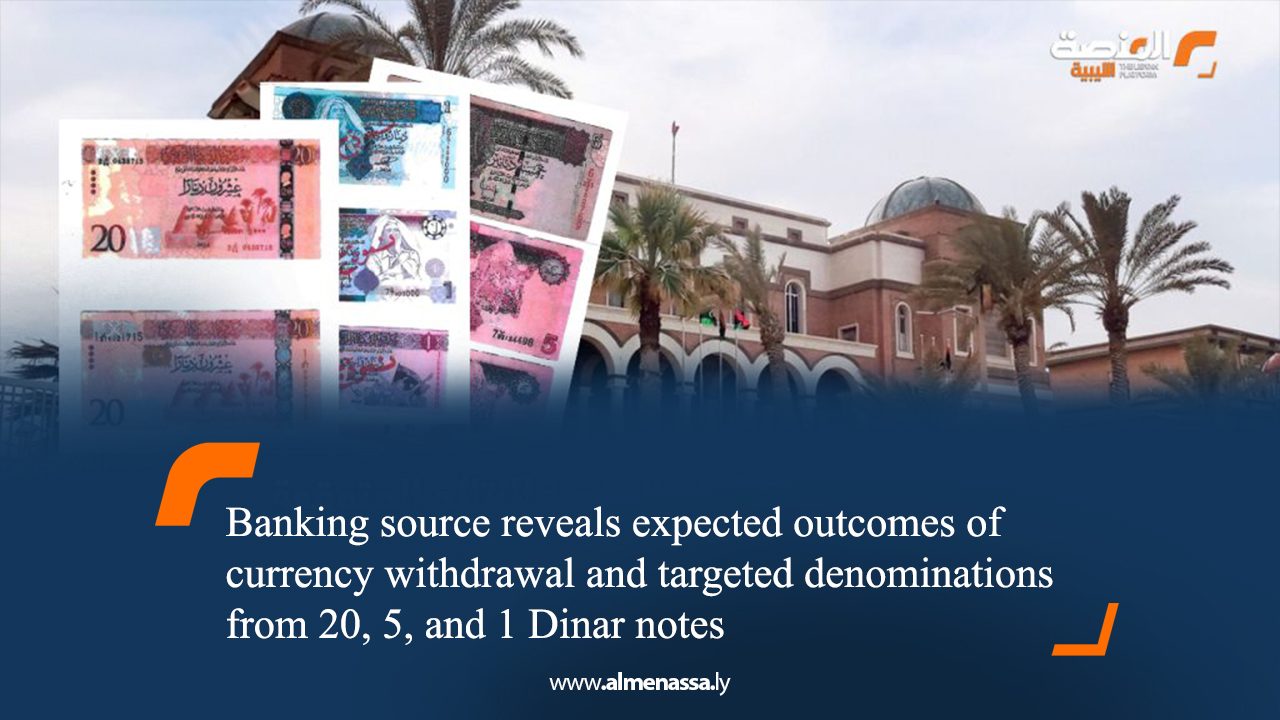The Central Bank of Libya (CBL) is continuing its regulatory measures concerning the local currency, following a record high in cash outside the banking sector at the end of 2024, reaching 48.8 billion Dinars.
The 50-Dinar denomination:
A banking source, speaking to Al-Manassa, stated that the CBL’s Board of Directors is pressing ahead with its “monetary reform process,” which began with the complete cessation of transactions involving the 50-Dinar note, the highest Libyan currency, by the end of last April.
The source explained that the CBL discovered last week that 16.5 billion Dinars in 50-Dinar notes had been collected, against an actual printed value of only 13 billion Dinars. This implies an additional 3.5 billion Dinars circulating outside the CBL’s authority, described by the source as “counterfeit.”
The 20-Dinar denomination:
The banking source continued to detail the CBL’s measures to rectify monetary policy for Al-Manassa, noting that Governor Naji Issa announced days ago the withdrawal of the 20-Dinar note from its first and second issues by the end of next September.
The source clarified that this denomination accounts for 21 billion Dinars in the local market, or the equivalent of 1.050 billion banknotes, suggesting the presence of counterfeit quantities within this sum, according to the Central Bank’s estimates.
The 5-Dinar denomination:
The CBL’s decisions also included the withdrawal of the 5-Dinar note from its sixth, seventh, and seventh amended issues, popularly known in Libya as the “Trilia” note due to its distinctive red colour.
The source confirmed that this denomination represents 1.5 billion Dinars of circulating cash, or the equivalent of 300 million banknotes.
The 1-Dinar denomination:
The same source informed Al-Manassa about the reasons behind the CBL’s withdrawal of the 1-Dinar note from its sixth, seventh, and seventh amended issues, which are valued at 500 million Dinars in the local market, or the equivalent of 500 million banknotes.
The source explained that the Dinar notes bearing images and symbols from the previous regime have not sufficiently returned to the CBL’s coffers, making the recent announcement a new opportunity for those still holding them to deposit them and take advantage of the specified deadline.
Objectives of currency withdrawal decisions:
The banking source, who preferred to remain anonymous, enumerated to Al-Manassa the various advantages of withdrawing certain currency denominations. He affirmed that the decision grants the CBL the ability to remove any counterfeit notes from circulation, alongside regaining control over cash outside banks and regulating it. It also aims to re-circulate liquidity and re-inject it into commercial banks according to the CBL’s plan, ensuring smooth financial movement.
These measures also aim to contain currency circulating at Libya’s borders in black markets and unofficial exchange shops, which pose a challenge to the national economy. Additionally, the plan seeks to inject new currency made from durable “polymer” material, distinguished by its longer lifespan and higher quality compared to the older paper currency.
Unifying the Dinar:
The banking official explained to Al-Manassa the CBL’s intention to address the division experienced by the Dinar, both “paper and metallic,” between the western and eastern regions of Libya. While some commercial establishments and individuals in Benghazi do not accept the paper Dinar, the metallic Dinar is not accepted in Tripoli, though it circulates normally in the southern and central cities.
The source described this situation as “monetary distortion,” confirming the bank’s intention to study the possibility of addressing this crisis later this year, after extensive discussion within the Board of Directors to take necessary measures and withdraw suspect denominations, ultimately leading to the unification of the Dinar’s value across the country.
CBL urges banks to detect counterfeit currency:
On June 17, the CBL Governor issued a directive to the general managers of commercial banks, emphasising the need for sufficient diligence in detecting any counterfeit currency that might enter commercial banks, especially when withdrawing 5-Dinar, 20-Dinar, and 1-Dinar denominations. This emphasis aims to prevent a repeat of the 50-Dinar scenario, where a large portion entered banks while being outside the CBL’s authority, leading to significant losses.
Printing 30 billion new Dinars:
The CBL announced in November 2024 the commencement of printing 30 billion Dinars in 5-Dinar, 10-Dinar, and 20-Dinar denominations. The issuing department is set to gradually inject this new currency into the local market to replace withdrawn currencies and provide sufficient liquidity in commercial banks, supporting economic activity.


